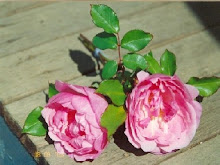
The bushfires in the Hawkesbury (2hrs NW of Sydney) on Christmas Night 2001 were the straw that broke the camels back; maintaining my home & young nursery in a rainshadow area with poor soil had been hard enough - so a 6 month search led me here, historically one of the most drought proof, prime agricultural districts in New South Wales. The house arrived in 2 parts by truck from Wagga in December 2002 & we arrived January 29, 2003.
(we = Jane & 2 dogs, 3 cats, 2 ponies, 1 cow & hundreds of pots). 

The drought was really biting, hardly a weed in sight. The front verandah, facing east, was the only source of shade (from late afternoon) so it was initially 'home' for the pots. I'd bought old carpet with me to use as a base and rigged up some shade for the tiny number of real shade lovers who'd come for the ride (not many of them left now).


Mid April, & my first houseguests, for one night, arrived about 4 hours after the driveway & carpark gravel base was spread....

Waiting for decent rain
before mulching, the ph was verylow (4 - 4.5) so I'd already generously limed the beds...


Look at those beautiful emerald green paths! Actually it is my 'bonsai canola', ie capeweed prior to flowering - we've found ourselves in a weed heaven, but never mind the garden has started and the plants are happy. It is just so good to be gardening again, the construction phase was fun, but, the novelty of laying 5,000 bricks for edging diminished part way through the exercise...

the site of the 'Tea Row' hedge (above at 6 months of age, 31 December 2003) was a result of the bobcat operators work! After digging & refilling the absorption trench, he spread a 30m x 2m wide layer of red clay subsoil (about 6" deep) in a line about 1.5 metres beyond the trench - a section of this 'red line' is visible on the right hand side of the first pictured in this series.
Iwas less than impressed when I first saw this eyesore - in such barren emptiness it seemed imposing & was at an angle that contradicted some of my early garden layout ideas. Apparently it was built to prevent damage to the trench during heavy rainstorms, but given my plans for the 'yard' that wasn't likely
(early lesson: think about what a bobcat operator will do with surplus subsoil).I didn't want to leave it as a 'lawn area', and rather than spread or remove the soil, chose to work with it, and that is how the 'Tea Row' was born - just the right width and not a bad length either...











































